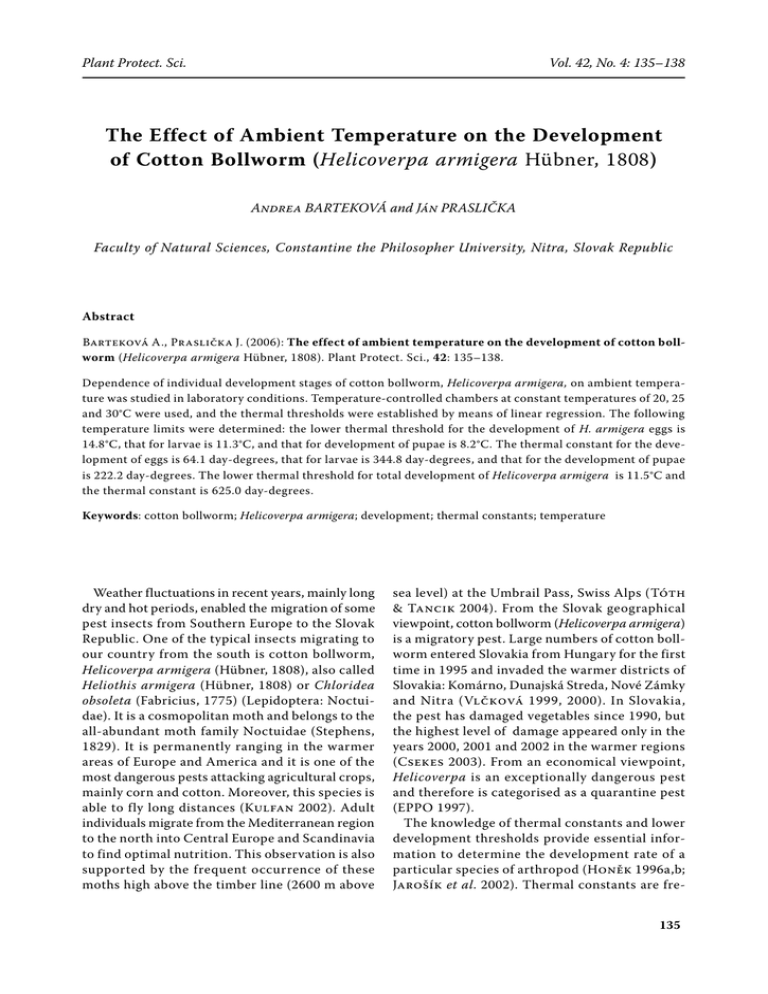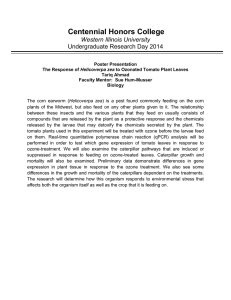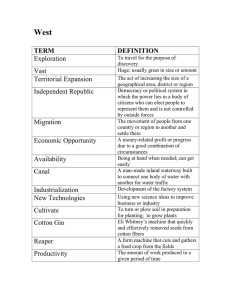The Effect of Ambient Temperature on the Development of Cotton
advertisement

Plant Protect. Sci. Vol. 42, No. 4: 135–138 The Effect of Ambient Temperature on the Development of Cotton Bollworm (Helicoverpa armigera Hübner, 1808) ANDREA BARTEKOVÁ and JÁN PRASLIČKA Faculty of Natural Sciences, Constantine the Philosopher University, Nitra, Slovak Republic Abstract BARTEKOVÁ A., PRASLIČKA J. (2006): The effect of ambient temperature on the development of cotton bollworm (Helicoverpa armigera Hübner, 1808). Plant Protect. Sci., 42: 135–138. Dependence of individual development stages of cotton bollworm, Helicoverpa armigera, on ambient temperature was studied in laboratory conditions. Temperature-controlled chambers at constant temperatures of 20, 25 and 30°C were used, and the thermal thresholds were established by means of linear regression. The following temperature limits were determined: the lower thermal threshold for the development of H. armigera eggs is 14.8°C, that for larvae is 11.3°C, and that for development of pupae is 8.2°C. The thermal constant for the development of eggs is 64.1 day-degrees, that for larvae is 344.8 day-degrees, and that for the development of pupae is 222.2 day-degrees. The lower thermal threshold for total development of Helicoverpa armigera is 11.5°C and the thermal constant is 625.0 day-degrees. Keywords: cotton bollworm; Helicoverpa armigera; development; thermal constants; temperature Weather fluctuations in recent years, mainly long dry and hot periods, enabled the migration of some pest insects from Southern Europe to the Slovak Republic. One of the typical insects migrating to our country from the south is cotton bollworm, Helicoverpa armigera (Hübner, 1808), also called Heliothis armigera (Hübner, 1808) or Chloridea obsoleta (Fabricius, 1775) (Lepidoptera: Noctuidae). It is a cosmopolitan moth and belongs to the all-abundant moth family Noctuidae (Stephens, 1829). It is permanently ranging in the warmer areas of Europe and America and it is one of the most dangerous pests attacking agricultural crops, mainly corn and cotton. Moreover, this species is able to fly long distances (KULFAN 2002). Adult individuals migrate from the Mediterranean region to the north into Central Europe and Scandinavia to find optimal nutrition. This observation is also supported by the frequent occurrence of these moths high above the timber line (2600 m above sea level) at the Umbrail Pass, Swiss Alps (TÓTH & TANCIK 2004). From the Slovak geographical viewpoint, cotton bollworm (Helicoverpa armigera) is a migratory pest. Large numbers of cotton bollworm entered Slovakia from Hungary for the first time in 1995 and invaded the warmer districts of Slovakia: Komárno, Dunajská Streda, Nové Zámky and Nitra (VLČKOVÁ 1999, 2000). In Slovakia, the pest has damaged vegetables since 1990, but the highest level of damage appeared only in the years 2000, 2001 and 2002 in the warmer regions (CSEKES 2003). From an economical viewpoint, Helicoverpa is an exceptionally dangerous pest and therefore is categorised as a quarantine pest (EPPO 1997). The knowledge of thermal constants and lower development thresholds provide essential information to determine the development rate of a particular species of arthropod (HONĚK 1996a,b; JAROŠÍK et al. 2002). Thermal constants are fre135 Vol. 42, No. 4: 135–138 Plant Protect. Sci. quently used to create predictive models of pest development in various environments, including stored products (SUBRAMANYAM et al. 1990), greenhouses and orchards (GRAF et al. 1996). Despite the fact that Helicoverpa armigera belongs to the most dangerous pests of agricultural crops, there is a lack of published data on the lower developmental threshold and temperature constants for this key pest. Thus, the aim of this study was to determine the lower development threshold and thermal constants for its development. The temperature-dependence of the developmental rates and thermal thresholds were established by means of linear regression. For each temperature, rates of developments (DR) were calculated as reciprocals of development time (DT) of individual cotton bollworm stages (DR = 1/DT). The relations between developmental rate (DR) and temperature (T) were described by a function (the regression line equation): MATERIALS AND METHODS The lower developmental threshold (LDT), i.e. the temperatures when development ceases, was determined: The study intended to evaluate the effect of ambient temperature on the development of individual cotton bollworm (Helicoverpa armigera Hübner) stages. The experiment was performed at three constant temperatures of 20, 25 and 30 ± 0.5°C. To establish a laboratory culture, we used cotton bollworm females collected from light traps and placed in an insectary where the females layed eggs; these were collected daily and placed into an incubator. The larvae were separated after hatching, and were individually fed with corn seeds until pupation. Overall, we observed 204 cotton bollworm individuals; only 180 of 204 individuals developed to adult stage and were statistically evaluated: 20 individuals at 20°C, 20 individuals at 25°C and 20 individuals at 30°C. Every experimental group was repeated three times. DR = a + bT (1) where: a, b – parameters of the linear regression LDT = –a/b (2) The sums of effective temperatures (SET), i.e. number of day-degrees above LDT necessary for completion of development: SETk = 1/b (3) RESULTS AND DISCUSSION Temperature dependence of Helicoverpa armigera development is summarised in Table 1. The duration of embryonic development of cotton bollworm was 11.17 days at 20°C, 7.00 days at 25°C and 4.07 days at 30°C. The results of previous stu- Table 1. Temperature dependence of Helicoverpa armigera development 20°C DT (mean) DR 25°C DT (mean) DR 30°C DT (mean) DR LDT SET N Egg 11.17 0.090 7.00 0.143 4.07 0.246 14.8 64.1 60 Larva 39.30 0.025 24.57 0.041 18.27 0.055 11.3 344.8 60 Pupa 18.40 0.054 14.07 0.071 10.10 0.099 8.2 222.2 60 Total development 68.87 0.015 45.63 0.022 32.43 0.031 11.5 625.0 180 Stage DT – development time in days; DR – development rate (DR = 1/DT); LDT – lower developmental threshold; SET– sums of effective temperatures; N – number of statistically evaluated individuals 136 Plant Protect. Sci. Development rate (1/DT) 0.30 Vol. 42, No. 4: 135–138 egg 0.25 Figure 1. Temperature dependence of Helicoverpa armigera development larva 0.20 pupa 0.15 total development 0.10 0.05 0.00 5 10 15 20 25 30 35 Ambient temperature (°C) dies are similar to our results. However, VLČKOVÁ (1999, 2000) reported that the larval development stage lasts 3 days at 25°C and 10–11 days in colder weather. Other authors (ANONYMOUS 2003) reported hatching of larvae after 3 days at 27–28°C. VALENTINE (1998) demonstrated larvae hatching in a natural environment 7–10 days after the eggs were laid. HACKETT and GATEHOUSE (1982) recorded larvae hatching in a natural environment already 4–5 days after the eggs were laid. The temperature influence on egg development is also described by the regression line equation (DR = 0.0156T – 0.2314). The line (Figure 1) shows that the developmental rate of egg increased with increasing temperature, indicating the positive correlation between both variables. This relation was also proven by a highly indicative correlation coefficient (r 2 = 0.97). According to the regression line equation we computed the lower developmental threshold (LDT) of H. armigera eggs to be 14.8°C, and the thermal constant for the development of eggs (SET) as 64.1 day-degrees. At 20°C, the development of larvae took 39.3 days. With increasing temperature, the development time of the larval stage shortened, i.e. at 25°C to 24.57 days, and at 30°C to 18.27 days. A similar developmental time necessary for larvae in a natural environment was also recorded by other authors. VLČKOVÁ (1999, 2000) established the developmental time of first generation larvae of cotton bollworm at 24–36 days, and the second generation at 19–26 days. VALENTINE (1998) reported 28–42 days of larval development, depending on temperature. The temperature dependence of larval development is also expressed by the regression line equation (DR = 0.0029T – 0.0329; r 2 = 0.99). According to the regression line equation the lower developmental threshold (LDT) of H. armigera larvae was 11.3°C, and the thermal constant for their development (SET) was 344.8 day-degrees. On average, the pupal stage took 10–18 days, i.e. 18.4 days at 20°C, 14.07 days at 25°C and 10.1 days at 30°C. Similar values for the pupal stages were recorded by VLČKOVÁ (1999, 2000). With the first generation, the pupal stage took 13–19 days, with the second generation (in August) 8–15 days, and in cold weather (in September) up to 44 days. MATLÁK (1995) states that the cotton bollworm pupal stage lasts 14 days (provided pupae do not diapause) in natural conditions. Thus, ambient temperature affects pupal development time similarly to the previous two development stages, which is also proven by the regression line equation (DR = 0.0045T – 0.0368; r 2 = 0.98). According to this equation, the lower developmental threshold (LDT) of H. armigera pupae was 8.2°C, and the thermal constant for the development of pupae (SET) 222.2 day-degrees. Natural conditions like higher temperatures and more precipitation in spring and high temperatures in summer have a favourable effect on the development of cotton bollworm. Higher temperatures also favour its extension to higher geographic latitudes (TÓTH & TANCIK 2004). Thermal constants can be used to predict the time of appearance of H. armigera larvae in crops. For example, from the data gained in this study, it can be expected that the larvae of H. armigera appear 7 days after the eggs were laid at locations with an average temperature of 25°C. This information may be useful for predicting when to use a treatment with insects as natural enemies to parasitise eggs of Helicoverpa armigera (e.g. by Trichogramma species), or for predicting the timing of a barrier 137 Vol. 42, No. 4: 135–138 chemical treatment against bollworm larvae in field crops and commodities. As a consequence, treatment with natural insect enemies should be applied within 64.10 day-degrees after the eggs were laid. Within this critical SET an insecticide can be expected to have a low efficiency. Insecticide treatment should be applied within 344.83 day-degrees after larvae appear. References ANONYMOUS (2003): Helicoverpa armigera (Hübner). Tomato fruitworm, Old World bollworm; http://www. inra.fr/Internet/Produits/HYPPZ/RAVAGEUR/6helarm. htm, HYPP Zoology online CSEKES Z. (2003): Nebezpečná mora bavlníková (Helicoverpa armigera) ohrozuje dozrievajúce plody zeleniny. Naše pole, 2: 46–47. EPPO (1997): Quarantine Pests for Europe. CAB International. GRAF B., HÖHN B.G., HÖPLI H.U. (1996): The apple sawfly, Hoplocampa testudinea: a temperature driven model for spring emergence of adults. Entomologia Experimentalis et Applicata, 78: 301–307. HACKETT D.S., GATEHOUSE A.G. (1982): Diapause in Heliothis armigera (Hübner) and H. fletcheri (Hardwick) (Lepidoptera: Noctuidae) in the Sudan Gezira. Bulletin of Entomological Research, 72: 409–422. ΗONĚK A. (1996a): The relationship between thermal constants for insect development: a verification. Acta Societatis Zoologicae Bohemicae, 60: 115–152. Plant Protect. Sci. HONĚK A. (1996b): Geographical variation in thermal requirements for insect development. European Journal of Entomology, 93: 303–312. JAROŠÍK V., HONĚK A., DIXON A.F.G. (2002): Developmental rate isomorphy in insects and mites. The American Naturalist, 160: 497–510. KULFAN J. (2002): Červivé rajčiaky. Záhradkár, 8: 60–61. MATLÁK J. (1995): Mora bavlníková – nový polyfágny škodca. Poľnohospodárska výroba a skúšobníctvo, 3 (3–4): 24–25. SUBRAMANYAM B., HAGSTRUM D.W., HAREIN P.K. (1990): Upper and lower temperature for development of six stored-product beetles. In: Proceedings 3 rd International Working Conference Stored-Product Protection. Bordeaux, France. Vol. III: 2029–2036. TÓTH P., TANCIK J. (2004): Plodová zelenina, tabak a fazuľa čelia silnejúcemu tlaku mory bavlníkovej. Naše pole, 2: 32–33. VALENTINE E.W. (1998): Tomato Fruitworm Life Cycle. The Horticulture and Food Research Institute of New Zealand Ltd.; http://www.hortnet.co.nz/publications/ hortfacts/hf401009.htm VLČKOVÁ H. (1999): Karanténni škodcovia v rýchliarniach. Poľnohospodárska výroba a skúšobníctvo, 7 (1): 8. VLČKOVÁ H. (2000): Mora bavlníková na Slovensku. Informace pro zahradnictví, 10: 17. Received for publication March 27, 2006 Accepted after corrections November 21, 2006 Corresponding author: RNDr. ANDREA BARTEKOVÁ, Univerzita Konštantína Filozofa v Nitre, Fakulta prírodných vied, Katedra zoológie a antropológie, Nábrežie Mládeže 91, 949 74 Nitra, Slovenská republika tel.: + 421 907 670 199, e-mail: abartekova@ukf.sk 138



